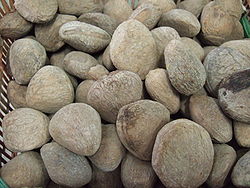| Pangium | |
|---|---|
 | |
| Plate from book: Flora de Filipinas | |
| Scientific classification | |
| Kingdom: | Plantae |
| Clade: | Tracheophytes |
| Clade: | Angiosperms |
| Clade: | Eudicots |
| Clade: | Rosids |
| Order: | Malpighiales |
| Family: | Achariaceae |
| Genus: | Pangium Reinw. |
| Species: | P. edule |
| Binomial name | |
| Pangium edule Reinw. [2] | |
| Synonyms [3] | |
| |
| Nutritional value per 100 g (3.5 oz) | |||||||||||||||||||||||||||||||||
|---|---|---|---|---|---|---|---|---|---|---|---|---|---|---|---|---|---|---|---|---|---|---|---|---|---|---|---|---|---|---|---|---|---|
| Energy | 462 kJ (110 kcal) | ||||||||||||||||||||||||||||||||
23.9 g | |||||||||||||||||||||||||||||||||
| Sugars | 14.1 g | ||||||||||||||||||||||||||||||||
| Dietary fiber | 6.2 g | ||||||||||||||||||||||||||||||||
2 g | |||||||||||||||||||||||||||||||||
2.3 g | |||||||||||||||||||||||||||||||||
| |||||||||||||||||||||||||||||||||
| †Percentages estimated using US recommendations for adults, [4] except for potassium, which is estimated based on expert recommendation from the National Academies [5] | |||||||||||||||||||||||||||||||||
Pangium is a genus in the family Achariaceae containing the sole species Pangium edule, a tall tree native to the mangrove swamps of Southeast Asia (Indonesia and Papua New Guinea [6] ). It produces a large poisonous fruit (the "football fruit" or pangi) [7] which can be made edible by fermentation. It is dioecious, with male and female flowers produced on separate individuals. [8]
Contents
The taxonomy of the tree is uncertain, and it may also be classed in the Flacourtiaceae [6] or the Violales.

